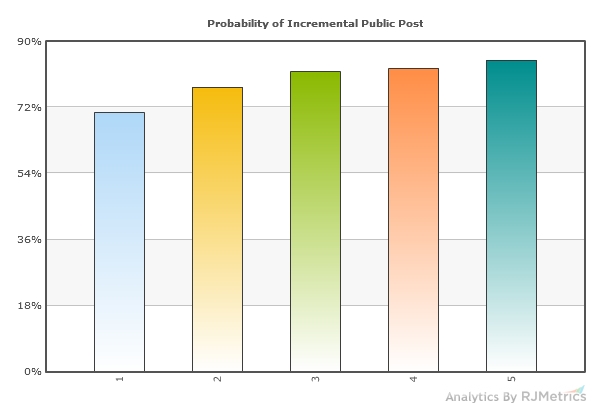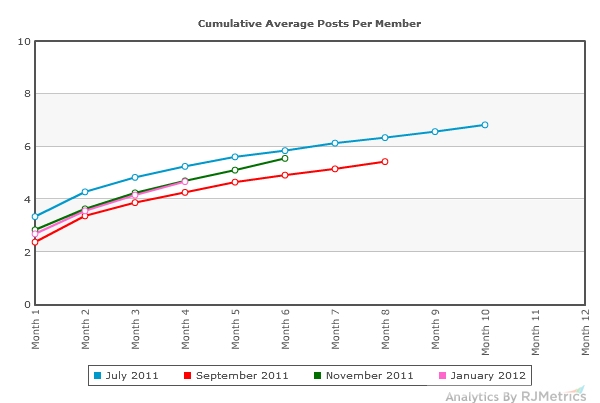Google CEO Larry Page recently announced that Google Plus crossed over the 100 million user mark and continues to see strong user growth.
Despite these strong numbers, however, the service continues to be pummeled in the press. Many outlets have claimed that engagement is poor and that growth is only fueled by Google forcing membership upon users of its other products.
Rather than rely on third-party reports, we decided to pull publicly available data on a random population into an RJMetrics online dashboard and see for ourselves.
Here are some of our most interesting findings:
- The average post has less than one +1, less than one reply, and less than one re-share.
- 30% of users who make a public post never make a second one. Even after making five public posts, there is a 15% chance that a user will not post publicly again.
- Among users who make publicly-viewable posts, there is an average of 12 days between each post
- A cohort analysis reveals that, after a member makes a public post, the average number of public posts they make in each subsequent month declines steadily. This trend is not improving in newer cohorts.
How We Did It
We began by selecting a population of 40,000 random Google Plus users. For each user, we downloaded their entire public timelines (which consist of all publicly-visible activities for that user). Only one third of the users in our population had any public activity, so this sub-set of the population is the main focus of many of our statistics.
Once we had the data, it was a snap to upload it to RJMetrics and pull the insights seen here with just a few clicks.
Since we are looking at public data exclusively, we want to point out that this data is not necessarily reflective of the entire population of users. These are simply insights into the public-facing actions of Google Plus users based on a population that is known to post publicly.
Repeat Posters
Once a user has made one public post, the chances that they will make a second post are quite strong: around 70%. After that, however, Google Plus does not perform as well as other social services that have analyzed. In charts like these, we typically expect to see the probability of repeat posts shoot up to well north of 90% by the time the user has made several posts. This is basically the “once you’re using it you’re hooked” principle.
With Google Plus, however, this number never crosses the 90% mark. Even after having made five such posts, the chance of making a sixth is only 85%. The means that 15% of people who have made five posts never came back to make a sixth.
Cohort Analysis
The cohort analysis below shows the rate at which new publicly-viewable posts are created by users who made their first post in different months throughout time.
This is a cumulative chart, so we’re basically showing the “average number of total posts made” as it grows over time for users in each cohort.
The decay rate here is very concerning. Users are less and less likely to make additional posts even a few months after initially joining. While it may not be an apples-to-apples comparison, it’s interesting to contrast this with the same chart from our Pinterest Data Analysis, which shows no decay whatsoever.
Time Between Posts
We were surprised at the by the length of time between public posts among users. On average, a user waits 15 days between making their first public post and making their second. This number declines with each subsequent post, but not drastically. There is an average of 10 days between a user’s fifth and sixth public posts.
The overall average time between any two public posts by the same user is 12 days.
Remember that, since we are only looking at public posts, it is very possible that users are making non-public posts in between the ones that we were able to see. Despite this, however, we were still quite surprised by the large amount of time between public posts.
+1s, Replies, and Sharing
Of all the categories, we feel that this is the least likely to be biased by the fact that we only studied public posts. These public posts will still be visible to each member’s private networks, and actually could attract +1s, shares, and replies from external users as well. If anything, we would expect our numbers here to be higher than in the general population.
Despite that, our population of nearly 70,000 posts yielded the following properties:
- An average of 0.77 “+1s” per post
- An average of 0.54 replies per post
- An average of 0.17 re-shares per post
Conclusion
From what we can see from the outside looking in, Google Plus has a long way to go before it becomes a real threat to the social networking landscape. While user growth is strong, it is unclear how much of that is driven by tie-ins with other Google products.
At the end of the day, Google Plus simply does not show the same level of ravenous user adoption and engagement that we’ve seen in other social networks (see our reports on Pinterest Data and Twitter Data for examples).




Pingback: Guy Kawasaki and 10 Experts Chime in on the Value of Google Plus
Pingback: Google +: What Does It Really "Add"? | B.B. Media Relations
Pingback: Popular Social Networks | jeff's awesome blog
Pingback: Is rel=author Really a Good Way to Judge Sources of Good Content? | SEO And Web Company
Pingback: On Google’s big earnings day, Google+ notable as a no-show | Technology News | CNET News | IT News
Pingback: On Google’s big earnings day, Google+ is a no-show | WestPenn Journal
Pingback: On Google's big earnings day, Google+ is a no-show | TopTech - Latest Tech News
Pingback: On Google’s big earnings day, Google+ is a no-show | Tech TV
Pingback: On Google’s big earnings day, Google+ is a no-show | bubonka.com
Pingback: Google+ why is Google covering up its lack of stickiness | socialbizandtech
Pingback: Überholt Google (plus) Facebook? | Mike Schwede
Pingback: Google+ 2:nd place means nothing without user engagement | dokuknej
Pingback: Is relauthor Really a Good Way to Judge Sources of Good Content | #KiiPass
Pingback: Google Plus’ Lack Of Vanity Addresses | Idea Labs Consulting
Pingback: 8 Compelling Reasons to Use Google Authorship | SEO Infromation Blog | Free SEO Tips and Resources |
Pingback: If a Tree Falls in the Forest, Does it Make a Sound: The Google+ Story | Barly by Ryan Gonzales